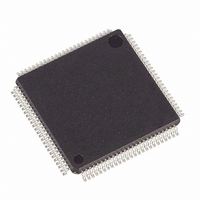DS2155L Maxim Integrated Products, DS2155L Datasheet - Page 6

DS2155L
Manufacturer Part Number
DS2155L
Description
IC TXRX T1/E1/J1 1-CHIP 100-LQFP
Manufacturer
Maxim Integrated Products
Specifications of DS2155L
Function
Single-Chip Transceiver
Interface
E1, HDLC, J1, T1
Number Of Circuits
1
Voltage - Supply
3.14 V ~ 3.47 V
Current - Supply
75mA
Operating Temperature
0°C ~ 70°C
Mounting Type
Surface Mount
Package / Case
100-LQFP
Includes
BERT Generator and Detector, CMI Coder and Decoder, HDLC Controller
Lead Free Status / RoHS Status
Contains lead / RoHS non-compliant
Power (watts)
-
Available stocks
Company
Part Number
Manufacturer
Quantity
Price
Part Number:
DS2155L
Manufacturer:
DALLAS
Quantity:
20 000
Part Number:
DS2155L+
Manufacturer:
MAXIM/美信
Quantity:
20 000
Part Number:
DS2155LB
Manufacturer:
DALLAS
Quantity:
20 000
Company:
Part Number:
DS2155LC2+
Manufacturer:
Infineon
Quantity:
95
Company:
Part Number:
DS2155LNB+
Manufacturer:
Maxim
Quantity:
100
Company:
Part Number:
DS2155LNC2+
Manufacturer:
ROHM
Quantity:
2 000
Part Number:
DS2155LNC2+
Manufacturer:
MAXIM/美信
Quantity:
20 000
DS2155
1.1 Table of Figures
Figure 3-1. Block Diagram ........................................................................................................................................ 15
Figure 3-2. Receive and Transmit LIU...................................................................................................................... 16
Figure 3-3. Receive and Transmit Framer/HDLC ..................................................................................................... 17
Figure 3-4. Backplane Interface ................................................................................................................................ 18
Figure 4-1. 10mm CSBGA Pin Configuration .......................................................................................................... 32
Figure 6-1. Programming Sequence .......................................................................................................................... 39
Figure 8-1. Clock Map............................................................................................................................................... 45
Figure 16-1. Simplified Diagram of Receive Signaling Path .................................................................................... 83
Figure 16-2. Simplified Diagram of Transmit Signaling Path................................................................................... 89
Figure 20-1. CRC-4 Recalculate Method ................................................................................................................ 109
Figure 24-1. Typical Monitor Application .............................................................................................................. 144
Figure 24-2. CMI Coding ........................................................................................................................................ 146
Figure 24-3. Software-Selected Termination, Metallic Protection.......................................................................... 156
Figure 24-4. Software-Selected Termination, Longitudinal Protection................................................................... 157
Figure 24-5. E1 Transmit Pulse Template ............................................................................................................... 159
Figure 24-6. T1 Transmit Pulse Template ............................................................................................................... 159
Figure 24-7. Jitter Tolerance.................................................................................................................................... 160
Figure 24-8. Jitter Tolerance (E1 Mode) ................................................................................................................. 160
Figure 24-9. Jitter Attenuation (T1 Mode) .............................................................................................................. 161
Figure 24-10. Jitter Attenuation (E1 Mode) ............................................................................................................ 161
Figure 24-11. Optional Crystal Connections ........................................................................................................... 162
Figure 26-1. Simplified Diagram of BERT in Network Direction .......................................................................... 171
Figure 26-2. Simplified Diagram of BERT in Backplane Direction ....................................................................... 171
Figure 28-1. IBO Example ...................................................................................................................................... 186
Figure 29-1. ESIB Group of Four DS2155s ............................................................................................................ 187
Figure 33-1. T1 Transmit Flow Diagram ................................................................................................................ 194
Figure 33-2. E1 Transmit Flow Diagram ................................................................................................................ 195
Figure 34-1. JTAG Functional Block Diagram ....................................................................................................... 199
Figure 34-2. TAP Controller State Diagram............................................................................................................ 202
Figure 35-1. Receive-Side D4 Timing..................................................................................................................... 208
Figure 35-2. Receive-Side ESF Timing................................................................................................................... 208
Figure 35-3. Receive-Side Boundary Timing (Elastic Store Disabled)................................................................... 209
Figure 35-4. Receive-Side 1.544MHz Boundary Timing (Elastic Store Enabled).................................................. 209
Figure 35-5. Receive-Side 2.048MHz Boundary Timing (Elastic Store Enabled).................................................. 210
Figure 35-6. Transmit-Side D4 Timing ................................................................................................................... 210
Figure 35-7. Transmit-Side ESF Timing ................................................................................................................. 211
Figure 35-8. Transmit-Side Boundary Timing (with Elastic Store Disabled) ......................................................... 211
Figure 35-9. Transmit-Side 1.544MHz Boundary Timing (Elastic Store Enabled) ................................................ 212
Figure 35-10. Transmit-Side 2.048MHz Boundary Timing (Elastic Store Enabled) .............................................. 212
Figure 35-11. Receive-Side Timing ........................................................................................................................ 213
Figure 35-12. Receive-Side Boundary Timing (with Elastic Store Disabled)......................................................... 213
Figure 35-13. Receive-Side Boundary Timing, RSYSCLK = 1.544MHz (Elastic Store Enabled) ........................ 214
Figure 35-14. Receive-Side Boundary Timing, RSYSCLK = 2.048MHz (Elastic Store Enabled) ........................ 214
Figure 35-15. Receive IBO Channel Interleave Mode Timing ............................................................................... 215
Figure 35-16. Receive IBO Frame Interleave Mode Timing................................................................................... 216
Figure 35-17. G.802 Timing, E1 Mode Only .......................................................................................................... 217
Figure 35-18. Transmit-Side Timing....................................................................................................................... 217
Figure 35-19. Transmit-Side Boundary Timing (Elastic Store Disabled) ............................................................... 218
Figure 35-20. Transmit-Side Boundary Timing, TSYSCLK = 1.544MHz (Elastic Store Enabled) ...................... 218
Figure 35-21. Transmit-Side Boundary Timing, TSYSCLK = 2.048MHz (Elastic Store Enabled) ....................... 219
Figure 35-22. Transmit IBO Channel Interleave Mode Timing .............................................................................. 220
6 of 238












